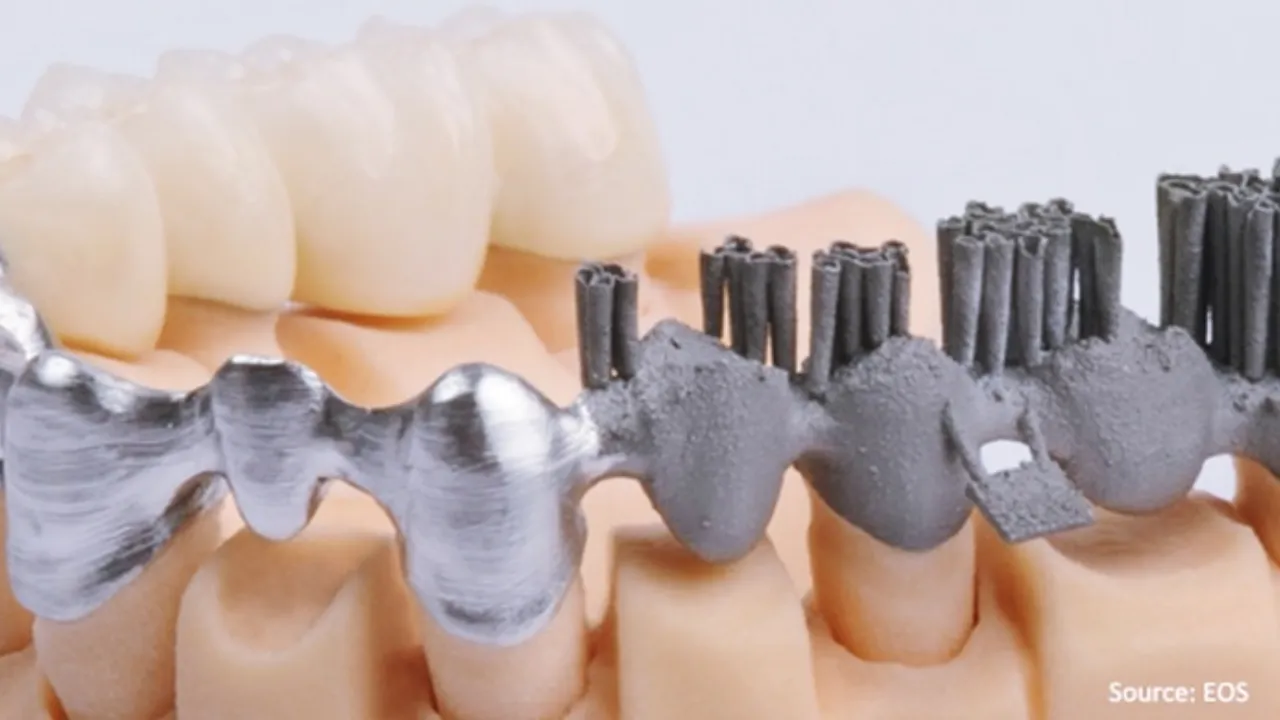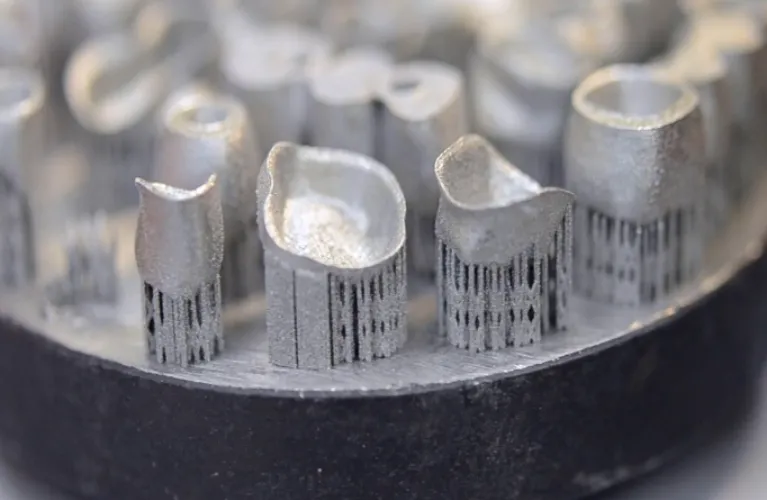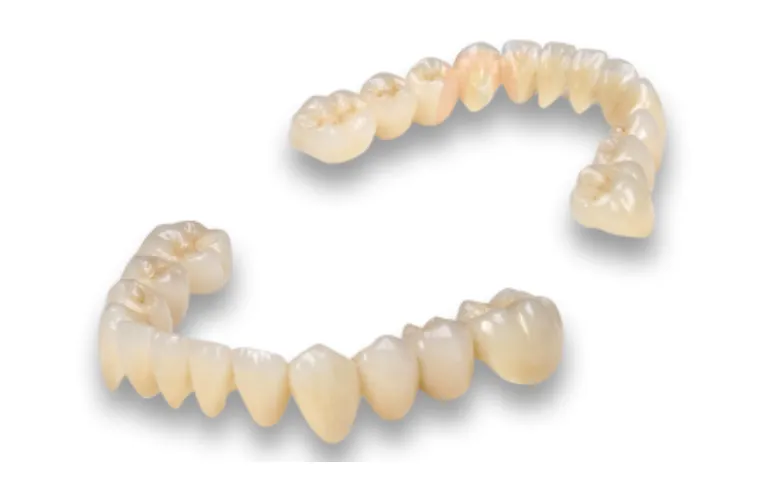
What is Direct metal laser sintering (DMLS) | What is DMLS Crown ? | DMLS Crown In Vadodara

What Are DMLS Crowns?
DMLS crowns are fabricated using Direct Metal Laser Sintering (DMLS), a cutting-edge 3D printing technology. This process uses a laser to selectively fuse metal powder particles layer by layer, creating a highly accurate and customized crown. The manufacturing process for DMLS crowns includes the following steps:
Digital Scan
An intraoral scanner takes a digital scan of the patient’s tooth or the area requiring the crown. This scan generates a precise 3D digital model of the tooth and its surrounding structures.CAD Design
The digital scan is imported into computer-aided design (CAD) software, where the crown is designed based on the patient’s unique dental anatomy and requirements.DMLS 3D Printing
The CAD design is sent to a DMLS 3D printer. The printer uses a laser to sinter metal powder particles layer by layer, constructing the crown with exceptional precision.Post-Production Processes
After 3D printing, the crown undergoes additional procedures such as heat treatment and polishing to enhance its mechanical properties and aesthetics.Cementing the Crown
The finished crown is cemented onto the prepared tooth using dental cement, ensuring a precise and durable fit.
DMLS technology allows for the production of highly precise, customizable, and biocompatible dental crowns, making it a significant advancement in restorative dentistry.

The DMLS Process | DMLS Crown | CAD CAM Crown In Vadodara
- DMLS is a form of 3D printing that uses a laser to melt metal powder particles together to form solid objects.
- The process begins by creating a 3D model of the dental crown using computer-aided design (CAD) software.
- They then loaded the model into the DMLS machine, which spreads a thin layer of metal powder over a build platform.
- The laser selectively melts the powder particles in a predetermined pattern, according to the 3D model of the crown. The build platform then moves down, and another layer of powder is added and melted. This process is repeated until they build the entire crown up.
Traditional PFM Crown Vs DMLS Crown | Cad Cam Crown In Vadodara
- One of the key advantages of DMLS crowns is their precise fit. With traditional crown fabrication methods, dentists often face challenges in achieving an accurate fit due to manual errors or inconsistencies in the manufacturing process.
- However, DMLS technology ensures a perfect fit by precisely layering and fusing metal particles according to a digital design. This results in a crown that seamlessly integrates with the patient’s natural dentition, providing optimal functionality and comfort.
- Know More About DMLS Crown or CAD CAM Crown IN Vadodara
Materials Used for Biocompatible DMLS Crowns
Biocompatible metal alloys are commonly used for DMLS crowns to ensure safety and durability. The most frequently used materials include:
Cobalt-Chrome (Co-Cr)
Cobalt-chrome alloys are widely used for their exceptional durability, biocompatibility, and wear resistance. These alloys are ideal for long-lasting dental restorations.Titanium and Titanium Alloys
Known for their low density, high corrosion resistance, and excellent biocompatibility, titanium crowns are lightweight and suitable for patients with metal sensitivities. They are a great option for lighter, more patient-friendly restorations.Other Metal Alloys
Alloys such as stainless steel, gold, and precious metal blends (e.g., gold-platinum) are also used. These materials are chosen based on the patient’s preferences, specific dental needs, or aesthetic considerations.
Benefits of DMLS Crowns | DMLS Crown In Vadodara
Precision and Accuracy:
- DMLS and CAD/CAM crowns offer exceptional precision and accuracy, ensuring a comfortable and seamless fit.
Durability:
- These crowns are incredibly durable and can last for many years with proper care.
- the use of metal alloys, such as cobalt-chrome or titanium, in the printing process enhances the strength and resilience of these crowns.
- This enables them to withstand the rigors of everyday oral functions, such as biting and chewing, without compromising their structural integrity.
- DMLS crowns exhibit exceptional longevity, ensuring patients can enjoy their restored smiles for years to come
Aesthetics
- they make these crowns from high-quality materials that are safe for use in the human mouth and look natural.
Convenience:
- The use of DMLS and CAD/CAM technology allows for faster and more convenient crown fabrication, often resulting in just one appointment.
DMLS Crowns: Transforming Dentistry
The introduction of DMLS technology in dentistry has revolutionized dental restorations. Here are the primary advantages of DMLS crowns:
Superior Accuracy and Fit
DMLS crowns are crafted with exceptional precision, ensuring a highly customized fit. This results in improved patient comfort and usability.Enhanced Durability
Made from biocompatible metal alloys, DMLS crowns are strong and resistant to the forces of biting and chewing. Their durability minimizes the need for frequent replacements, making them a cost-effective long-term solution.Improved Aesthetics
DMLS technology allows for the customization of crown designs, resulting in lifelike appearances that seamlessly match the patient’s natural teeth.Biocompatibility
Safety is a key feature of DMLS crowns, as they are made from materials like cobalt-chrome and titanium that are highly compatible with oral tissues, promoting overall health and well-being.Integration with Digital Dentistry
DMLS crowns are part of a fully digital workflow, incorporating CAD/CAM technology for optimal results. This improves accuracy, efficiency, and patient communication.Optimized Design Capabilities
DMLS technology enables dentists to achieve unparalleled crown shape, size, and fit precision. Intricate details such as occlusal anatomy and surface textures can be easily incorporated into the design.
Advantages
Incredibly thinner margins when compared with conventional PFM reduces plague formation around crown.
- The CAD process while fabricating detects and eliminates undercut up to 0.2 mm
- The CAM process facilitates equal space for ceramic binding and avoids ceramic chip-off
- Full Arch bridges of up to 16 units can be fabricated
- The fabrication of long-span bridges through Laser sintering eliminates rocking
- The high precision allows easy crown fixing
Indications
- Single crown
- Fixed Bridges
- Implant Hybrid Framework (DC Hybrid)
- DMLS crowns have revolutionized the field of restorative dentistry by combining advanced 3D printing technology, durability, precision fit, and exceptional aesthetics. With their precise fit, long-lasting durability, and natural appearance, DMLS crowns offer patients a reliable and attractive solution for restoring damaged or missing teeth. As this technology continues to advance, it holds great promise for further enhancing dental care and improving patient outcomes.


